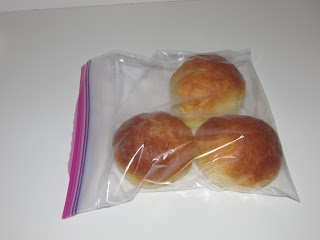At any rate, I wanted to share with you another use for corn cobs today. This is the recipe that I use for corn cob jelly. I don't much care for it, but some people like it, and it is certainly unique. Corn cob jelly is also a particularly efficient thing to make on a wood cookstove because of the long cooking time and the fact that you can burn the by-products from this process in your stove later on.
This recipe was given to me by Marsha S. from Carson, Iowa, and if I remember right, it belonged to her mother. We worked together sometimes during my banking days, and I quite enjoyed talking to her about food--actually, I enjoy talking to anybody about food.
The first step in making corn cob jelly is to choose a dozen corn cobs. Look for cobs that are relatively clean and are as dark red as possible because they will tint your finished jelly a prettier color.
 |
| Some corn cobs in a five-gallon bucket on the kitchen floor. |
Wash and drain the corn cobs and break them into small pieces. The washing and draining isn't difficult, but I find that breaking them into small pieces can be challenging. I used a knife to aid this process, but it was still on the difficult side.
Put the clean broken corn cob pieces into a large kettle and add three pints of water. Place the pot of corn cobs directly over the fire and boil the cobs for a half hour with the lid on the kettle.
 |
| The broken corn cobs in the three pints of water coming to a boil over the firebox. |
If you are going to be water-bath canning this jelly on the wood cookstove, I would suggest that you start heating your canner of water while the corn cobs are boiling. This would also be a good time to get your jars washed and inverted on clean towels in the warming oven and your canning lids down in hot water.
Once the half hour has elapsed, strain the juice from the corn cobs. I accomplish this by putting an old piece of cotton tea-towel in a colander over a glass measuring cup. Don't get lazy and skip the cloth; you don't want corn chaff in the liquid.
 |
| Straining the juice off the cooked corn cobs. |
You will find that your three pints of liquid has reduced to about half the volume that you started with, and this is perfect because you want three cups of corn cob liquid. If you have a little more or a little less, either discard the extra or add hot water to make up the difference.
 |
| Three cups of the corn cob liquid. |
The rest of the ingredients that you will need are as follows:
- the juice of one lemon
- one box pectin (5 1/2 to 6 Tbsp. if you buy it in bulk)
- 3 cups granulated sugar, measured and ready in a separate bowl
 |
| All of the ingredients that go into corn cob jelly. I believe the glass juicer on the right belonged to my great-grandmother who was the first woman to live in our house. |
Combine the lemon juice and the pectin with the corn cob liquid and put them in a heavy-bottomed stock pot. Place the pot directly over the hottest part of the cooktop and bring to a boil as rapidly as possible. For this step, you need to have a raging fire going, and I find it is best accomplished with sticks of a one- to two-inch diameter.
 |
| A shot of the raging fire needed for making jelly. |
Once the mixture has come to a full boil, add the three cups of sugar. Return to a full rolling boil as quickly as possible and let the mixture boil for exactly three minutes. (Yes, this is correct. In fruit jellies this is usually just one minute.)
Remove the entire kettle from the fire, skim any foam, and pour immediately into the hot canning jars from the warming oven. Seal and process in the hot water bath for 10 minutes.
 |
| You can see the fire still running hot while the jars of jelly are processing directly above the firebox. |
For me, this recipe yields four 8 oz. jars and one 4 oz. jar of jelly. You can see the amber color that this batch turned out to have. Sometimes, it is slightly more pink than this.
I threw the boiled cobs out onto the cement patio to dry in the sun and had burned a few of them as kindling before the snow covered them over.
It feels strange to share a recipe on this blog that I don't like, but I feel this is a good recipe because the end product tastes exactly like some professionally made corn cob jelly that I was once given as a gift. It does add a nice color to the jelly shelf, and for those who like the taste of field corn or do not have enough exposure to it to reckon it as a barnyard taste and smell, this could be quite enjoyable.
Fill up the comments with your own version of this distinctive condiment or your thoughts thereon. Thanks for reading, and may your wood fires be burning brightly!













































